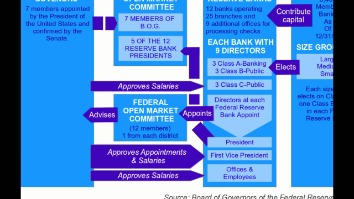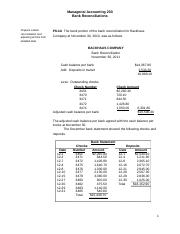
If you’re working for yourself, you (or your accountant or bookkeeper) will perform bank reconciliation. But if multiple people handle your business’s finances, the person reconciling the accounts should probably be different from the person signing the checks. This will ensure your unreconciled bank statements don’t pile up into an intimidating, time-consuming task. One reason for this is that your bank may have service charges or bank fees for things like too many withdrawals or overdrafts.
How Often Should You Reconcile Bank Statements?
When completed, the reconciliation should show the correct cash balance. There will be very few bank-only transactions to be aware of, and they’re often grouped https://www.quickbooks-payroll.org/ together at the bottom of your bank statement. If you find any bank adjustments, record them in your personal records and adjust the balance accordingly.
Bank Reconciliation: Purpose, Example, and Process
With bank statement in-hand, you can systematically check off matching transactions one-by-one by clicking their boxes. The bottom of the screen contains a running total of items you have checked off, and thus have been reconciled. This is useful for comparing the totals in your books to the totals on your bank statement. To complete the reconciliation, make sure the difference shown is zero. Not recording all transactions in the accounting system can lead to discrepancies between the balance sheet and the bank statement, making it difficult to reconcile. The final step in the bank reconciliation process is to record journal entries to complete the balancing process.

Step 5: Create journal entries
The bank reconciliation statement explains the difference between the balance in the company’s records and the balance in the bank’s records. Book transactions are transactions that have been recorded on your books but haven’t cleared the bank. As a small business, you may find yourself paying vendors and creditors by issuing check payments.
- Hopefully, once you’ve dealt with deposits in transit, outstanding checks, interest payments, and bank fees, your bank statement and internal accounting records will match.
- There will be very few bank-only transactions to be aware of, and they’re often grouped together at the bottom of your bank statement.
- Also, when transactions aren’t recorded promptly and bank fees and charges are applied, it can cause mismatches in the company’s accounting records.
- In such a case, your bank has recorded the receipts in your business account at the bank.
- This process involves matching the amounts and dates of each transaction to ensure that they are consistent across both sets of records.
inventory and cost of goods solds compare transactions from financial records with those on a bank statement. Where there are discrepancies, companies can identify and correct the source of errors. Reconcile all transactions and ensure that the closing balances match on the balance sheet and the bank statements. If you’re interested in automating the bank reconciliation process, be sure to check out some accounting software options. Bank Example 2 showed that the bank debits the depositor’s checking account to decrease the checking account balance (since this is part of the bank’s liability Customers’ Deposits).
Step #5: Record All The Adjustments As Per Cash Book Into Your Company’s General Ledger Cash Account
Solutions such as HighRadius’s cash management software can auto-reconcile transactions based on standard and user-defined tagging rules, saving time and reducing the risk of errors. Reconciliation reports provide a summary of the reconciliation process and help to identify any errors or discrepancies. Failing to review these reports regularly can lead to errors in the reconciliation process. The final entry is to record the bank service charges that are deducted by the bank but have not been recorded on the records. You will be increasing your cash account by $5 to account for the interest income, while you’ll be reducing your cash account by $30 to account for the bank service fee. You can earn our Bank Reconciliation Certificate of Achievement when you join PRO Plus.
The key is to establish a routine that best suits your business’s unique needs and financial activity. Reconciling bank statements with cash book balances helps you, as a business, to know the underlying causes that lead to such differences. A bank reconciliation is part of the month-end close process, which includes reviewing the company’s balance sheet, https://www.accountingcoaching.online/opportunity-costs-and-the-production-possibilities/ income, bank statements, expenses, intercompany trades, and other information. It is essential for maintaining accurate business financial records, which helps in tax filing and gives an overall idea of the company’s finances. The purpose of the bank reconciliation is to be certain that the company’s general ledger Cash account is complete and accurate.
With QuickBooks, you can easily reconcile bank accounts to ensure that the dollars you record are consistent with the dollars reported by the bank. Add the amount of deposits in transit and subtract the amount of any outstanding checks from your bank statement’s cash balance to arrive at (and record) an adjusted bank balance. Similarly, add any interest payments or bank fees to your business’s cash accounts to find your adjusted cash balance. To reconcile bank accounts, compare your bank statement to your records, noting any discrepancies.

The Ascent is a Motley Fool service that rates and reviews essential products for your everyday money matters. The items shown in the book section arise from the previously unknown events. On the other hand, if the deposit was made earlier, it would be essential to determine why it hadn’t been received. A financial professional will offer guidance based on the information provided and offer a no-obligation call to better understand your situation. The articles and research support materials available on this site are educational and are not intended to be investment or tax advice. All such information is provided solely for convenience purposes only and all users thereof should be guided accordingly.
However, the depositor/customer/company credits its Cash account to decrease its checking account balance. However, the depositor/customer/company debits its Cash account to increase its checking account balance. When a company writes a check, the company’s general ledger Cash account is credited (and another account is debited) using the date of the check. Therefore, a check dated June 29 will be recorded in the company’s accounts using the date of June 29, even if the check clears (is paid through) the company’s bank account one week later. After receiving a bank statement dated 31 December 20×1 for a checking account at First National Bank, the accountant for Sample Company began the reconciliation process.
The bank sends the account statement to its customers every month or at regular intervals. The bank statement submitted by the businessman at the end of May will not contain an entry for the check, whereas the cash book will have the entry. As a result, a difference of $2,500 is caused between the two balances. Bank reconciliation statements safeguard against fraud in recording banking transactions. They also help to detect any mistakes in cash book and bank statement.



